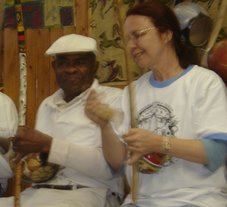 Now that I've run out of diary material to copy, I have to rely on my memory again. The photo I've added above shows a corner of Fort Santo Antônio além do Carmo (now the Capoeira Fort) with the eponymous church in the background
Now that I've run out of diary material to copy, I have to rely on my memory again. The photo I've added above shows a corner of Fort Santo Antônio além do Carmo (now the Capoeira Fort) with the eponymous church in the backgroundI don't remember what day it was - but it was sometime between January 1, 1987 and
Bonfim Day that I finally met a real-life mestre in Bahia and started learning Capoeira Angola.
It was one of the many days that I'd taken the Lacerda lift up to the upper city and hastened to Terreiro de Jesus plaza, which I'd mistaken for a Candomblé temple (or the site of one) when I first arrived because they are also called
terreiros. I'd been there many times before, and wandered as far as I dared in Pelourinho, long before it was turned into a relatively safe tourist theme park.
But this day was different. I know it was in early January 1987, on a Friday, because I was wearing white, in honour of Oxalá (Obatala). I had the wind at my back - perhaps a divine breeze - and it was pushing me towards the plaza with churches on three sides and a fountain in the centre. Some capoeiristas were playing a bout, surrounded by onlookers, and I joined the ring. Standing beside me was a man - slightly built, about my height - dressed all in white except for a black fedora hat.
I heard several people call him "mestre," with obvious deference and respect. Normally shy, I spent some time working up the courage to talk to him. "Are you a capoeira mestre?" I finally asked, in halting Portuguese. "According to some," he replied (modestly or deviously, I wasn't quite sure). After we'd spoken for a while, I discovered two things - one, that he spoke English, and two, that he had founded the Grupo de Capoeira Angola Pelourinho (GCAP), and held classes in a large space in a ruined fort on the very edge of the historic district, in Santo Antonio Além do Carmo. Even better, he offered to trade Capoeira classes for English lessons.
I told him that I'd learned bits and pieces of Capoeira Angola and Regional in LA, and he replied dryly, in perfect English: "Jack of all trades, and master of none". I was impressed.
Then he had me follow him through the maze-like streets of Pelourinho, past the blue church built by slaves for slaves, and up a sloping street that led to the Carmelite Convent. I was surprised to find that it seemed to be a perfectly safe, residential area, and wished I'd ventured there earlier (later Z explained that she meant it was dangerous at night, which is still true).
Then we walked down a long straight road that led to a large square overlooking the bay, with Bonfim church in the distance, and up to the gate of the crumbling fort. It opened onto a short dark tunnel, beyond which I could see a rubble and rubbish-strewn courtyard. For the first time since I'd met my new guide, I hesitated, but felt reassured by the presence of an elderly guard sitting near the entrance.
"Mestre Fedora" took me down the passage, across the courtyard, and up some steps to a grillwork door covered with a sheet of plywood and closed with a chain and padlock. Through a chink, we were able to get a glimpse of the room inside, with its distinctive black-and-white tile floor.
I was disappointed to find that he didn't have the key on him, but he said, "Come back tomorrow. We have class Tuesdays and Thursdays, with rodas on Saturdays and Sundays." I could see my first real Capoeira Angola roda the very next day!
As we walked back out of the fort, past the slumbering guard, and into the reassuring sunshine of Santo Antonio plaza, "Mestre Fedora," better known as
Moraes, turned to me with a sharp look and gave me my first painful lesson in Capoeira Angola and life: "Never, ever, let a stranger take you into a place like that again!"
They say that God protects innocents, fools and drunkards. Which, oh Lord, was I?





